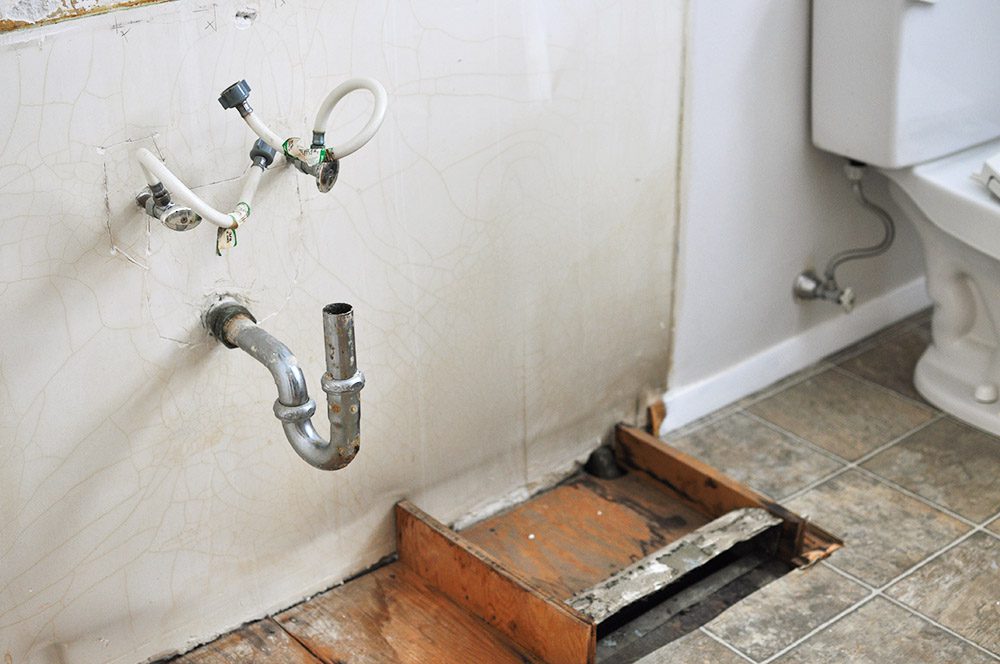Step One: Gather Tools & Materials
Master the Art of Bathroom Vanity Installation with the Right tools and Materials
Tools:
- Stud finder
- Level
- Tape measure
- Drill
- Screwdriver
- Saw
- Clamps
Materials:
- Vanity
- Sink
- Shims
- Caulk
Step Two: Measure the Area

Measuring your space to ensure that you purchase the correct size vanity is crucial when replacing a bathroom vanity. For instance, a double vanity setup necessitates more space and plumbing considerations. Refer to the vanity manufacturer's guidelines for specifics. If installing a vanity with a top, account for the countertop in your measurements.
Tip: Always measure twice for accuracy.
Step Three: Choose Your New Vanity and Faucet

With so many types of bathroom vanities to choose from, it’s important to decide what you prefer. There are vanities without an attached top. Some have faucets and some don't. From Carrara marble to granite and laminate, it’s important to choose the countertop material that works best for your lifestyle. Think of durability (granite and marble), style and your family’s needs while making your decision.
Tip: When shopping for a bathroom vanity, focus on the style of the counter. Hardware can be quickly and easily changed out to match your decor style.
Step Four: Remove the Old Vanity

Learning how to install a bathroom vanity starts with understanding how to install bathroom vanity plumbing. When removing a bathroom vanity, begin by locating the water shut-off valves. They are typically under the sink. (If your valves are not located underneath the sink, be sure to turn off the main water valve). Read on to walk through the details.
- Turn off the water supply.
- Quickly turn the faucets on to release any water pressure that’s built up in the pipes. Place a small bucket under the tubes to catch any water.
- Using an adjustable wrench, loosen the slip nut, or mounting nut, at the top of the P-trap. (These are the drain pipes named for the shape they make).
- Using the same wrench, disconnect the water supply lines.
- Use a utility knife to cut the sealant along the backsplash. Carefully pull on the sink or vanity top to remove it from the wall.
- Remove the sink top from the vanity base. Some tops use glue or brackets to adhere to the vanity. You may need to use your prybar to release the sink top from the base.
- Use your drill to take the screws at the base of the vanity out and remove it from the wall.
- Check with your local recycling and trash collection to be sure you dispose of your old vanity properly.
- Removing your vanity can cause small holes or marks in the wall. Patch any holes with spackling compound. Let this dry then sand lightly before you repaint.
Tip: Pay close attention when removing your old sink. This will help you to better understand how to attach a sink to the vanity.
Step Five: Install the New Vanity

- Position the new vanity into place and trace its outline on the wall.
- Use a stud finder to locate the studs and mark them.
- Level the vanity and shim at the floor if necessary.
- Measure, mark and drill holes for drain and supply pipes.
Tip: Some vanities will come with pre-drilled holes for easier installation. Always follow the manufacturer’s directions for how to install a bathroom vanity.
Step Six: Attach To the Wall
- Attach the vanity to the wall using 3-inch drywall screws. If the holes are not completely lining up, or you want a more secure install, use wall anchors to attach the vanity to the wall.
- Check the level again before trimming the shims with a utility knife.
- If there are large gaps at the wall or floor, attach quarter-round moulding along the wall or floor edge with finishing nails.
Step Seven: Attach Sink & Install Faucet

Below are general steps on how to attach the sink to the vanity and install the faucet:
- Place the sink on top of the vanity. Test fit the sink to ensure it fits snugly.
- Attach the sink clips to the underside of the vanity top to hold the sink in place.
- Assemble the bathroom faucet and drain on the sink before you attach it to the vanity.
- Place the plastic gasket on the faucet. Then, while holding the faucet from underneath, screw on fastening nuts.
- Insert the faucet into the designated holes on the vanity top.
- Attach water supply lines to the new faucet with an adjustable wrench.
Tip: Every vanity and sink brand can be different. Faucet installation can vary as well. Refer to the manufacturer’s instructions for specific details on all three.
Step Eight: Secure the Vanity Top
If you have chosen a bathroom vanity base, or a vanity without an attached top, you will need to make sure it fits first. Be sure to place the vanity top over the vanity before gluing it down.
- Make sure the wall is straight and there are no gaps between the wall and vanity.
- Apply silicone caulk to the top of the cabinet.
- Set the vanity top into position and firmly press down.
- Check to make sure the vanity top is level and flush to the wall. If your vanity does not come with adjustable legs, use shims under the base until vanity is level on each side.
- Add a bathroom vanity backsplash if necessary.
Tip: Be sure to follow the manufacturer’s instructions to secure the vanity top to the vanity.
Step Nine: Reconnect the Water Supply

- Reconnect the faucet supply lines to the water supply and reconnect the P-trap.
- Turn on the water supply and test for leaks.
- Install the pop-up drain.

